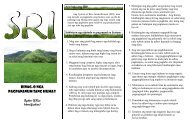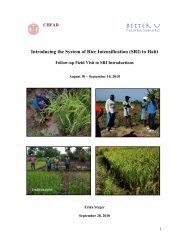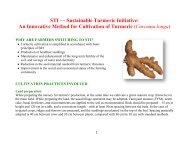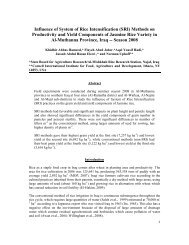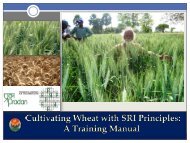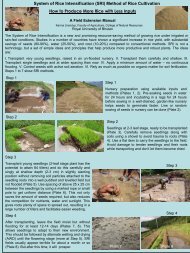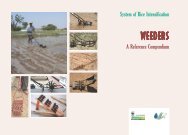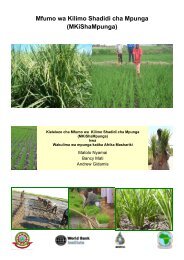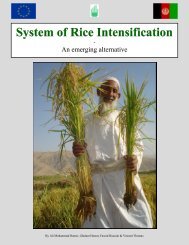EFFECT OF THE SYSTEM OF RICE INTENSIFICATION (SRI) ON ...
EFFECT OF THE SYSTEM OF RICE INTENSIFICATION (SRI) ON ...
EFFECT OF THE SYSTEM OF RICE INTENSIFICATION (SRI) ON ...
Create successful ePaper yourself
Turn your PDF publications into a flip-book with our unique Google optimized e-Paper software.
However even with this roll-on effect and free interpretation it is questionable how <strong>SRI</strong> will<br />
develop and in what form in the future. There is a tendency that farmers practising <strong>SRI</strong> after some<br />
time will mix <strong>SRI</strong> with some of their traditional methods and thus move away from <strong>SRI</strong> (Ma<br />
Veasna – personal communication, 2008). Such tendencies are in accordance with the findings from<br />
Moser & Barrett (2003) on disadoption rates amongst <strong>SRI</strong> farmers in Madagascar. CEDAC is<br />
providing various extension services: <strong>SRI</strong>, production of organic fertilizers, pesticide reduction,<br />
developing farmer associations, saving groups etc. (CEDAC, 2008c). The ILFARM project is<br />
ending in October 2009 (CEDAC, 2008c) which raises the question, how will <strong>SRI</strong> survive without a<br />
strong organization like CEDAC providing extension and training? First of all <strong>SRI</strong> is not a set of<br />
rules to be strictly followed (Stoop & Kassam, 2005) and should not be regarded as a part of a TOT<br />
and T&V strategy but a tool farmers can use and adapt like they wish. Farmers have participated in<br />
<strong>SRI</strong> training sessions and have been involved throughout the process. Therefore the sustainability<br />
must be larger – as the more participatory a project is, the more sustainable it is. Matteson (2000)<br />
states that the conversion of development projects changing strategy from T&V to FFS experienced<br />
much higher success rates, as farmers were involved more throughout the process of the project.<br />
CEDAC did not use FFS but similar training strategies thus <strong>SRI</strong> would probably still be practiced<br />
by the target farmers in the future but perhaps in a different set up.<br />
However considering the major impact CEDAC has had with the farmers during the project the lack<br />
of extension services after the end of the project might result in some farmers moving away from<br />
<strong>SRI</strong>. The target farmers are now used to have some sort of access to extension through CEDAC<br />
after the end of the project they will suddenly face another truth. Probably the most labour intensive<br />
techniques will be left out such as. e.g. compost production and farmers who can afford chemical<br />
fertilizers will increase in using it which is most likely the richer farmers. Poorer farmers might still<br />
use compost production as means of supplying nutrients to their farming system.<br />
9.5.4 Can farmers produce enough compost/GM for the future expansion of their <strong>SRI</strong> fields?<br />
This section will evaluate if farmers will be able to produce enough compost and apply enough<br />
biomass for the increase in area of <strong>SRI</strong> production for the season of 2009. According to the findings<br />
from the household survey as mentioned earlier, the farmers will in average expand their <strong>SRI</strong> from<br />
the present 534 m 2 to 3676 m 2 . According to CEDAC (2008a), 14% of interviewed household in<br />
the ILFARM project area are in average able to produce 2.550 kg of compost per year and 81% of<br />
60



